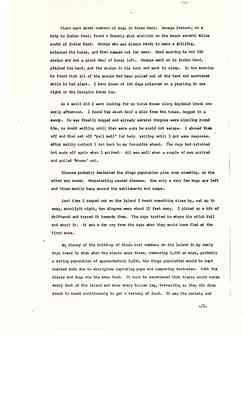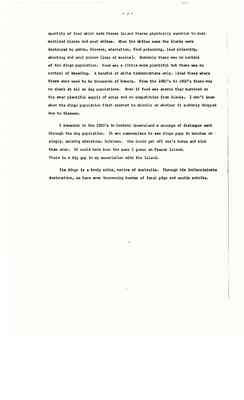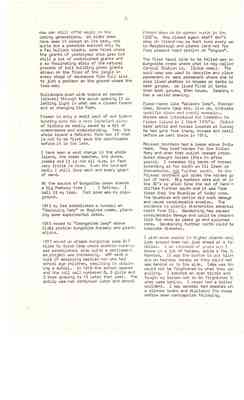Pages
USC295_0021
DINGOES ON FRASER ISLAND A comment by Rollo Petrie
Up to 1920's to my knowledge there were very many dingoes on theIsland. Large packs would serenade when winter started prior to their breeding season. No matter where one happened to be at night there would be always a corroboree of the dingoes. Last year's pups' voices were distinguishable among the older talent.
When riding along the ocean beach as we frequently did travelling from Eurong to Bowarrady or to Indian Head it was commonplace to have ten or more dingoes following. Fresh ones joined and others dropped out as they reached their territory boundaries. (Dingoes travel great distances when necessary. In the west I have known them to travel 40 miles to and from water).
On the Island there was no worry about water, but in those days food was not plentiful. It would not be pleniful now if there was an equivalent number of dogs on Fraser Island as there was in the early 1900's. The few dingoes now on the Island could live comfortably on scraps and garbage scavenged from campers and fishermen but in the early days they would have to work hard to survive.
I have seen bullocks (working) bogged in the peat swamps while trying to reach feed. They would sink in the mud until it was impossible for them to move. The dingoes would start eating them from the rear. I have seen a beast with its tail and rump eaten out and along its back, flesh removed. The beast remained alive. Dingoes caught the odd wallaby. Although there were not many wallabies there were plenty of bandicoots.
On the mainland, where there were plenty of pademelon wallabies, kangaroo rats, echidnas, goannas and snakes, I have known dingoes to kill bandicoots and leave them lie. Domestic dogs will rarely eat bandicoot but they are very fond of possum or any of the other game. Bandicoots were fairly plentiful in the 1915 to '20's in the Woogoolbver area. Bandicoot used to be reckoned as a choice dish by a lot of bush people years ago, who dubbed the saying, "Bandicoot pie Number One KAI."
A considerable source of food for dingoes on Fraser Island was Wongs (Eugorie). This was readily apparent by observing the dingoes' dung. The wongs were chewed up shell and all. The shell fragments in quantity passed on through the bowel in some cases with the shell almost completely intact.
/2
USC295_0022
There were great numbers of dogs in those days. George Jackson, on a trip to Indian Head, found a freshly shot stallion on the beach several miles south of Indian Head. George who was always ready to make a shilling, poisoned the horse, and then camped not far away. Next morning he had 100 scalps and not a great deal of horse left. George went on to Indian Head, pitched his tent, put the scalps in his tent and went to sleep. In the morning he found that all the scalps had been pulled out of the tent and scattered while he had slept. I have known of 100 dogs poisoned on a yearling in one night on the Georgina River too.
As a small kid I went looking for my horse Moses along Bogimbah Creek one early afternoon. I found him about half a mile from the house, bogged in a swamp. He was freshly bogged and already several dingoes were circling round him, no doubt waiting until they were sure he could not escape. I shooed them off and then set off "pell mell" for help yelling until I got some response. After making contact I ran back to my favourite steed. The dogs had returned but made off again when I arrived. All was well when a couple of men arrived and pulled "Moses" out.
Disease probably decimated the dingo population plus over crowding, or the other way round. Overstocking caused disease. Now only a very few dogs are left and those mostly hang around the settlements and camps.
Last time I camped out on the island I heard something close by, sat up in swag, moonlight night, two dingoes were about 15 feet away. I picked up a bit of driftwood and tossed it towards them. The dogs trotted to where the stick fell and smelt it. It was a far cry from the days when they would have fled at the first move.
My theory of the build-up of those vast numbers on the Island in my early days there is that when the Blacks were there, numbering 2,000 or more, probably a roving population of approximately 3,000, the dingo population would be kept checked both due to aborigines capturing pups and competing food-wise. Both the blacks and dogs ate the same food. It must be remembered that blacks would cover every inch of the Island and know every hollow log, travelling as they did from coast to coast continuously to get a variety of food. It was the variety and ./3.
USC295_0023
-3quantity of food which made Fraser Island blacks physically superior to most mainland blacks and most whites. When the whites came the blacks were destroyed by germs, disease, starvation, food poisoning, lead poisoning, shooting and soul poison (loss of morale). Suddenly there was no control of the dingo population. Food was a little more plentiful but there was no control of breeding. A handful of white timbercutters only, lived there where there once used to be thousands of humans. From the 1880's to 1900's there was no check at all on dog populations. Even if food was scarce they survived on the ever plentiful supply of wongs and no competition from blacks. I don't know when the dingo poplulation first started to dwindle or whether it suddenly dropped due to disease.
I remember in the 1950's in Central Queensland a scourge of distemper went through the dog population. It was commonplace to see dingo pups in batches or singly, walking skeletons, hairless. One could get off one's horse and kick them over. It could have been the same I guess on Fraser Island. There is a big gap in my association with the Island
The dingo is a truly noble, native of Australia. Through his indiscriminate destruction, we have ever increasing hordes of feral pigs and exotic rabbits.
USC295_0024
SOME REMINISCENCES BY ROLLO PETRIE OF FRASER ISLAND 1913-1922
The lifestyle at the time I was growing up on the Island was perhaps different to most mainland areas, though not so different from the more remote areas - all had to be very self reliant. The isolation by water of Fraser posed a problem for the first few years. There was no regular boat. Accidents and sickness had to be dealt with chiefly by available means - no doctors or nurses. My mother though with no professional training whatever (medical) nursed the sick, mended big wounds with needle and cotton, treated burns successfully, brought babies into the world when more white women came to the Island, only two white women (excepting Lighthouse Sandy Cape), when we first came to Fraser. Quite a lot later also a motorboat which incidentally was quite often stuck on a sand bank or engine on the blink. Early on we depended on the gun and crabhook fishing line for our meat diet. When vegetables, spuds and onions etc. ran short we always had the palm cabbage which was more like cauliflower to eat, yams of finest quality and plentiful if you knew where to look and we kids did. Several kinds of berries made excellent drinks.
The diet was ever being varied, pigeon, duck, fish, crabs, wongs and oysters when time or opportunity permitted and occasionally (very) if Skipper Armitage was coming in on a late night tide (in winter time) he would bring a parcel of steak, walk up the several miles to our house, spend rest of night and have breakfast. On one such occasion arriving about midnight at Orangetree Camp, Dad hung the steak on the veranda facia board, during the night a bush cat jumped from railing and carried the meat to the ground (sand) ate what it required and left the rest, a disappointed family at breakfast - Sequence Dad built a trap and following night cat came back (only the once).
Sometimes a cask of cornbeef would arrive. O.K. winter, but summer after being on hot deck for 'praps two tides quite often was buried on arrival. However really we lived like kings. My mum was an excellent cook as were most women in those days. We thought she was exceptional tho.
On a humourous nature, one Cassells, can't think of his christian name cut his foot rather badly with an axe. He had just got a pair of new boots, he was brought to Mu who bathed the wound then, patient sittin on chair with foot on Mum's knee. M arme with needle and thread (no dope) can't spell anaesthetic, each time the needle wa forced through his tough hide would bring forth a groan loud and tailing off to a pitiful, "oh my new bloody boot". Each stitch caused the same comments and there were quite a few stitches. A few weeks a another pair of boots later Cassells was back at work.
Many incidents of like nature, accidents like Skipper Armitage falling down the hold on his head, finished up with a stif neck. Two years later a fall off the Loc tender on a sleeper, on his head and when recovered, his neck was normal again. Buck Geoghan shooting telegraph wire unti it broke to get help when badly burned. In all years on Island I cannot recollect any loss of life - The worst I sa when about 10 years, a chap in falling of his horse at a gallop hit his head against a tree and was 3 months semi unconscious. I was the bloke who picked hi up, thought he was dead.
My Dad opened up the first forestry operation on Fraser. An experiment had been tried 30 years earlier unsuccessfully. Walter Petrie was a legend in his own tim silviculturally, a natural naturalist. If the relevant points in his study repo n Fraser Island 1913-22 were implemente the Island would be saved a lot of destruction.
John Sinclair is the man now who has the island at heart and knows better than mo what should be done aout it. The big trouble is the almighty dollar. Heritag takes second place to money. Science an Technology have taken millions of jobs o the market and the same (I'm not going t try spelling it again) without commonsen will destroy Fraser Island.
It is as simple as picanniny daylight coming before dawn.
Rape the softwood scrubs, rainforests w modern machinery, any machinery, even th axe and crosscut saw the damage is irre airable but places like F.I. if halted
USC295_0025
2.
now can still offer magic to the coming generations. We older ones have seen it almost at its best, not quite but a paradise scarred only by a few bullock tracks, some holes where the giants of yesteryear once grew but still a lot of undisturbed giants and a so fascinating story of the natural process of soil building great giants strewn on the floor of the jungle in every stage of decompose from full size to just a pattern on the ground where the tree was.
Bulldozers push wide tracks at random (almost) through the scrub opening it up letting light in what was a closed forest and so changing its form.
Fraser is only a small part of our timber bearing area but a very important piece of history so easily saved by a bit of commonsense and understanding. yes, the whole Island a National Park but if that is not to be first save the rainforests before it is too late.
I have seen a vast change in the whole Island, the ocean beaches, the dunes, creeks and it is not all nice, in fact very little is nice. Even tho bruised badly I still love each and every grain of sand.
At the source of Wungoolba creek stands a big Peebcoy tree ( ) Satinay. I call it my tree. That area was my playground.
1913 my Dad established a nursery at "Depuyuing Camp" on Bogimba creek, planting some experimental areas.
1915 moved to "Orangetree Camp" above tidal portion Wungoolba Nursery and plantations.
1917 moved up stream Wungoolba some 6-7 miles to Scrub Camp where another nursery was established, also quite a settlement as a project was increasing. WRP made a rule of employing married men who had school age children, resulting in obtaining a school. In 1918 the school opened and the roll call numbered 8, 6 girls and 2 boys growing to 15 later that year. The policy was not continued later and school closed down to be opened again in the 1930's. now closed again staff don't stay on Island now as boat runs every we to Maryborough and planes land not far from present head station at "Ungowa".
The first Kauri pine to be felled was on Wungoolba creek where what is now called Central Station is. (Scrub camp). The word camp was used to describe any place permanent or semi permanent where one or more lived whether in houses or tents or bark gunyas. We lived first in tents then bark gunyas, then house. Camping n has a varied meaning.
Place names like "Walkers Camp", Sharman Camp, Browns Camp etc. live on, indicate specific place and recall memories. Horses were introduced for breeding to Fraser Island in I think 1870's. Aldrid bred cattle and horses located at Eurong He had gone from there. horses and cattl before we went there in 1913. McLever brothers had a lease above India Head. They bred horses for the Indian Army and when that outlet ceased introduced draught horses (this in after years). I remember big bands of horses extending as far south as Eli Creek or thereabouts, not further south. As the McLever brothers got older the horses go out of hand. Big musters were put on in the 30's by which time the out of hand h drifted further sosuth and it was from these that the Brumbies of today come. The Brumbies and cattle did much damage and cause considerable erosion. The evidence is plainly discernible especial north from Eli. Sandmining has caused considerable damage and could be respons ible for more as years go and cyclones come. Sandmining further north could be a complete disaster.
I wish more people in higher places woul look around them not just ahead at a fat dollar. I am reminded of years ago I broke in a lot of horses, quite a few to harness. It was the custom to put blink ers on harness horses so they could not see behind or to the side. Idea was the would not be frightened by what they wer pulling. I adopted an open bridle and taught my horses not to be frightened by what came behind. I never had a bolter accident. I saw several bad smashes whe a blinker broke and disclosed the never before seen contraption following.




